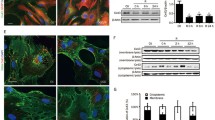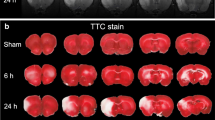Abstract
The aim of this study was to investigate the role of connexin 43 (Cx43) and its hemichannel (HC1) in the death of astrocytes following ischemia/reperfusion (IR) or oxygen–glucose deprivation/reoxygenation (OGDR) insult. Wistar rats had their bilateral common carotid artery clamped for 1.5 h followed by 0, 4, and 24 h of reperfusion (n = 8 for each time point), respectively. All rats were sacrificed and Cx43, HC1, and caspase 3 (Casp3) in cerebral ischemic tissues were examined by immunohistochemistry and western blotting. Astrocytes cell line, astrocytes transduced with a retroviral empty vector (Psup astrocyte), or a Cx43-specific shRNA construct (shRNA astrocytes) were treated with OGDR insult for various periods. The viability of astrocytes was assessed by MTT assay. The expression of Cx43, HC1, and Casp3 was detected with western blotting. The results showed that the expression of Cx43, HC1, and Casp3 in rats’ brain, astrocytes, and Psup astrocytes was significantly increased after 4 h of IR/OGDR and recovered on 24 h of the insult. Cell viability decreased after 4 h of the insult whereas the cell viability increased on 24 h after the insult. In contrast, the expression of Cx43, HC1, Casp3, and cell viability had no statistical differences in the null Cx43 gene—shRNA transfected astrocytes after the treatment of OGDR. The results suggest that Cx43 and HC1 are likely to play the pivotal roles in the mediation of the astrocytic death.






Similar content being viewed by others
References
Benjelloun N, Joly LM, Palmier B, Plotkine M, Charriaut-Marlangue C (2003) Apoptotic mitochondrial pathway in neurones and astrocytes after neonatal hypoxia–ischaemia in the rat brain. Neuropathol Appl Neurobiol 29:350–360
Bennett MV, Contreras JE, Bukauskas FF, Sáez JC (2003) New roles for astrocytes: gap junction hemichannels have something to communicate. Trends Neurosci 26:610–617
Carr AJ, Whitmore D (2005) Imaging of single light-responsive clock cells reveals fluctuating free-running periods. Nat Cell Biol 7:319–321
Cooper CD, Solan JL, Dolejsi MK, Lampe PD (2000) Analysis of connexin phosphorylation sites. Methods 20:196–204
Cusato K, Bosco A, Rozental R, Guimarães CA, Reese BE, Linden R, Spray DC (2003) Gap junctions mediate bystander cell death in developing retina. J Neurosci 23:6413–6422
Cusato K, Ripps H, Zakevicius J, Spray DC (2006) Gap junctions remain open during cytochrome c-induced cell death: relationship of conductance to ‘bystander’ cell killing. Cell Death Differ 13:1707–1714
De Vuyst E, Decrock E, Cabooter L, Dubyak GR, Naus CC, Evans WH, Leybaert L (2006) Intracellular calcium changes trigger connexin 32 hemichannel opening. EMBO J 25:34–44
De Vuyst E, Decrock E, De Bock M, Yamasaki H, Naus CC, Evans WH, Leybaert L (2007) Connexin hemichannels and gap junction channels are differentially influenced by lipopolysaccharide and basic fibroblast growth factor. Mol Biol Cell 18:34–46
Evans WH, De Vuyst E, Leybaert L (2006) The gap junction cellular internet: connexin hemichannels enter the signalling limelight. Biochem J 397:1–14
Gomes P, Srinivas SP, Van Driessche W, Vereecke J, Himpens B (2005) ATP release through connexin hemichannels in corneal endothelial cells. Invest Ophthalmol Vis Sci 46:1208–1218
Halestrap AP, Clarke SJ, Javadov SA (2004) Mitochondrial permeability transition pore opening during myocardial reperfusion—a target for cardioprotection. Cardiovasc Res 61:372–385
Kalvelyte A, Imbrasaite A, Bukauskiene A, Verselis VK, Bukauskas FF (2003) Connexins and apoptotic transformation. Biochem Pharmacol 66:1661–1672
Kang J, Kang N, Lovatt D, Torres A, Zhao Z, Lin J, Nedergaard M (2008) Connexin 43 hemichannels are permeable to ATP. J Neurosci 28:4702–4711
Krutovskikh VA, Piccoli C, Yamasaki H (2002) Gap junction intercellular communication propagates cell death in cancerous cells. Oncogene 21:1989–1999
Krysko DV, Leybaert L, Vandenabeele P, D’Herde K (2005) Gap junctions and the propagation of cell survival and cell death signals. Apoptosis 10:459–469
Li F, Sugishita K, Su Z, Ueda I, Barry WH (2001) Activation of connexin-43 hemichannels can elevate [Ca(2+)]i and [Na(+)]i in rabbit ventricular myocytes during metabolic inhibition. J Mol Cell Cardiol 33:2145–2155
Lipton P (1999) Ischemic cell death in brain neurons. Physiol Rev 79:1431–1568
Martínez AD, Sáez JC (2000) Regulation of astrocyte gap junctions by hypoxia–reoxygenation. Brain Res Brain Res Rev 32:250–258
Orellana JA, Sáez PJ, Shoji KF, Schalper KA, Palacios-Prado N, Velarde V, Giaume C, Bennett MV, Sáez JC (2009) Modulation of brain hemichannels and gap junction channels by pro-inflammatory agents and their possible role in neurodegeneration. Antioxid Redox Signal 11:369–399
Piper HM, García-Dorado D, Ovize M (1998) A fresh look at reperfusion injury. Cardiovasc Res 38:291–300
Plotkin LI, Manolagas SC, Bellido T (2002) Transduction of cell survival signals by connexin-43 hemichannels. J Biol Chem 277:8648–8657
Ramachandran S, Xie LH, John SA, Subramaniam S, Lal R (2007) A novel role for connexin hemichannel in oxidative stress and smoking-induced cell injury. PLoS ONE 2:e712
Rana S, Dringen R (2007) Gap junction hemichannel-mediated release of glutathione from cultured rat astrocytes. Neurosci Lett 415:45–48
Retamal MA, Schalper KA, Shoji KF, Bennett MV, Sáez JC (2007) Opening of connexin 43 hemichannels is increased by lowering intracellular redox potential. Proc Natl Acad Sci USA 104:8322–8327
Rodríguez-Sinovas A, Cabestrero A, López D, Torre I, Morente M, Abellán A, Miró E, Ruiz-Meana M, García-Dorado D (2007) The modulatory effects of connexin 43 on cell death/survival beyond cell coupling. Prog Biophys Mol Biol 94:219–232
Sáez JC, Contreras JE, Bukauskas FF, Retamal MA, Bennett MV (2003) Gap junction hemichannels in astrocytes of the CNS. Acta Physiol Scand 179:9–22
Saraste A, Pulkki K (2000) Morphologic and biochemical hallmarks of apoptosis. Cardiovasc Res 45:528–537
Simek J, Churko J, Shao Q, Laird DW (2009) Cx43 has distinct mobility within plasma-membrane domains, indicative of progressive formation of gap-junction plaques. J Cell Sci 122:554–562
Solan JL, Lampe PD (2005) Connexin phosphorylation as a regulatory event linked to gap junction channel assembly. Biochim Biophys Acta 1711:154–163
Spray DC, Ye ZC, Ransom BR (2006) Functional connexin “hemichannels”: a critical appraisal. Glia 54:758–773
Stong BC, Chang Q, Ahmad S, Lin X (2006) A novel mechanism for connexin 26 mutation linked deafness: cell death caused by leaky gap junction hemichannels. Laryngoscope 116:2205–2210
Stridh MH, Tranberg M, Weber SG, Blomstrand F, Sandberg M (2008) Stimulated efflux of amino acids and glutathione from cultured hippocampal slices by omission of extracellular calcium: likely involvement of connexin hemichannels. J Biol Chem 283:10347–10356
Takeuchi H, Jin S, Wang J, Zhang G, Kawanokuchi J, Kuno R, Sonobe Y, Mizuno T, Suzumura A (2006) Tumor necrosis factor-alpha induces neurotoxicity via glutamate release from hemichannels of activated microglia in an autocrine manner. J Biol Chem 281:21362–21368
Thimm J, Mechler A, Lin H, Rhee S, Lal R (2005) Calcium-dependent open/closed conformations and interfacial energy maps of reconstituted hemichannels. J Biol Chem 280:10646–10654
Thompson RJ, Zhou N, MacVicar BA (2006) Ischemia opens neuronal gap junction hemichannels. Science 312:924–927
Van Zeijl L, Ponsioen B, Giepmans BN, Ariaens A, Postma FR, Várnai P, Balla T, Divecha N, Jalink K, Moolenaar WH (2007) Regulation of connexin43 gap junctional communication by phosphatidylinositol 4,5-bisphosphate. J Cell Biol 177:881–891
Vikhamar G, Rivedal E, Mollerup S, Sanner T (1998) Role of Cx43 phosphorylation and MAP kinase activation in EGF induced enhancement of cell communication in human kidney epithelial cells. Cell Adhes Commun 5:451–460
Vinken M, Vanhaecke T, Papeleu P, Snykers S, Henkens T, Rogiers V (2006) Connexins and their channels in cell growth and cell death. Cell Signal 18:592–600
Warn-Cramer BJ, Cottrell GT, Burt JM, Lau AF (1998) Regulation of connexin-43 gap junctional intercellular communication by mitogen-activated protein kinase. J Biol Chem 273:9188–9196
Ye ZC, Wyeth MS, Baltan-Tekkok S, Ransom BR (2003) Functional hemichannels in astrocytes: a novel mechanism of glutamate release. J Neurosci 23:3588–3596
Zvalova D, Cordier J, Mesnil M, Junier MP, Chneiweiss H (2004) p38/SAPK2 controls gap junction closure in astrocytes. Glia 46:323–333
Acknowledgments
The technical assistance of Mr. Tim Robson (Department of cell and developmental biology, UCL) is gratefully acknowledged. This work was supported by Shandong Natural Foundation, China to Prof. A. Ma, and Association of Medical Research Charities (AMRC), UK for a Project Grant to D.L.B.
Author information
Authors and Affiliations
Corresponding author
Additional information
Xueyu Wang and Aihua Ma are co-first authors of this article.
Rights and permissions
About this article
Cite this article
Wang, X., Ma, A., Zhu, W. et al. The Role of Connexin 43 and Hemichannels Correlated with the Astrocytic Death Following Ischemia/Reperfusion Insult. Cell Mol Neurobiol 33, 401–410 (2013). https://doi.org/10.1007/s10571-013-9906-y
Received:
Accepted:
Published:
Issue Date:
DOI: https://doi.org/10.1007/s10571-013-9906-y




